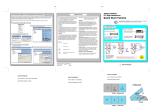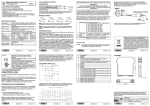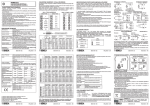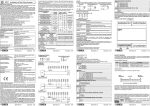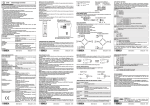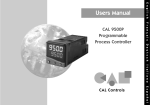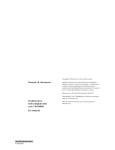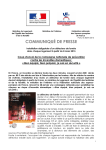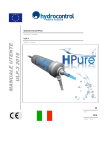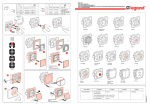Download Z-8TC Collegamenti Elettrici S + + + + + + + +
Transcript
Z-8TC CONVERTITORE PER TERMOCOPPIE CON ISOLAMENTO A SEI PUNTI Descrizione Generale Lo strumento Z-8TC è un convertitore digitale per termocoppie, con otto canali di misura, isolati dall’alimentazione e dalla linea di comunicazione seriale fino a 1.5 kV. Lo stesso isolamento pari a 1.5 kV è previsto tra canali facenti capo a gruppi diversi di morsetti. Il modulo è dunque caratterizzato da un isolamento complessivo a sei punti. In aggiunta esso è caratterizzato da: Cablaggio facilitato dell'alimentazione e del bus seriale per mezzo del bus alloggiato nella guida DIN. Configurabilità della comunicazione tramite DIP-switch o via software. Comunicazione seriale RS485 con protocollo MODBUS -RTU, massimo 32 nodi. Protezione contro scariche ESD fino a 4 kV. Elevata velocità di acquisizione. Misura di termocoppie: J, K, E, N, S, R, B, T. Misura degli ingressi disponibile nei seguenti formati: rappresentazione floating-point, floating-point inversa, virgola fissa a 16 bit, in decimi di grado con segno per la temperatura, decine di mV per la tensione. Canali attivabili singolarmente. Valore programmabile in caso di fault o congelamento ultima lettura . Per ciascuna coppia di ingressi relativi allo stesso gruppo di morsetti sono previste le seguenti impostazioni comuni: Misura impostabile in temperatura o mV. Filtro programmabile a otto livelli per la stabilizzazione della lettura. Reiezione programmabile a 50 Hz o 60 Hz. Tre diverse velocità di acquisizione selezionabili (due a 14 bit, una a 15 bit). Compensazione giunto freddo. Norme di installazione 10..40 Vdc o 19..28 Vac (50..60 Hz). max 0,6 W. Porte di Comunicazione Seriale : -RS485, 1200..115200 Baud. -RS232, 2400 Baud, Indirizzo:01, Parità: NO, Dati: 8 bit; Stop bit: 1. MODBUS-RTU. Protocollo : Ingressi Termocoppia di tipo: J, K, E, N, S, R, B, T. Ingresso : EN60584-1 (ITS-90). Tabelle : Dipendente dal tipo di termocoppia (vedere Tabella Range di temperatura : Range Termocoppie). -10,1..81,4 mV. Span mV: Impedenza : 10 MW. Errore complessivo : ADC 14 bit e Reiez. 50 Hz: "(0,040 % + 13 mV). ADC 15 bit e Reiez. 50 Hz: "(0,035 % + 10 mV). ADC 14 bit e Reiez. 60 Hz: "(0,045 % + 16 mV). ADC 15 bit e Reiez. 60 Hz: "(0,040 % + 12 mV). MI001230-I Corrente Test : (1) CMRR : (1) (2) DMRR : Collegamenti Elettrici IMPOSTAZIONE DEI DIP-SWITCH PORTA SERIALE RS485 E ALIMENTAZIONE I collegamenti elettrici relativi al bus RS485 e all’alimentazione sono disponibili esclusivamente utilizzando il bus per guida DIN Seneca. I collegamenti del connettore del bus per guida DIN sono visibili nella figura seguente. Power Supply AC- RS485 A RANGE TERMOCOPPIE Range Errore Errore Range TIPO TC Ammesso Linearizzazione Ammesso Linearizzazione S J -50..1768 °C -210..1200 °C 0,05 °C 0,02 °C -200..1372 °C R -50..1768 °C K 0,05 °C 0,02 °C -200..1000 °C B E 0,02 °C 0,03 °C 250..1820 °C (3) N -200..400 °C -200..1300 °C T 0,04 °C 0,04 °C Altre Caratteristiche Impostabile a 14 o 15 bit. ADC : < 100 ppm/K. Deriva Termica : Impostabile a 50 Hz o a 60 Hz. Reiezione ai disturbi : <1 °C. Errore Giunto Freddo : Tensione di isolamento : 1500 Vac tra porte di: alimentazione, comunicazione e ingresso. 1500 Vac tra canali relativi a gruppi di morsetti diversi. Grado di protezione : IP20. Condizioni ambientali : Temperatura -10..+65 °C, Salvataggio parametri in EEPROM garantito nel range: 0..50 °C. Umidità 30..90 % non condensante. Altitudine 2000 slm. Temp. Stoccaggio : -20..+85 °C. Segnalazioni LED : Alimentazione, Fail, Comunicazione RS485. Connessioni : -Morsetti a vite estraibili a 4 vie, max 1.5 mm2, passo 3.5 mm. -Connettore posteriore IDC10 per barra DIN. -Jack frontale stereofonico 3.5 mm per connessione RS232 (COM). PBT, colore nero. 100 x 112 x 17,5 mm, 140 g. EN61000-6-4/2002-10 (emissione elettromagnetica, ambiente industriale). EN61000-6-2/2006-10 (immunità elettromagnetica, ambiente industriale). EN61010-1/2001 (sicurezza). Tutti i circuiti devono essere isolati con doppio isolamento dai circuiti sotto tensione pericolosa. Il trasformatore di alimentazione deve essere a norma EN60742: “Trasformatori di isolamento e trasformatori di sicurezza”. (1) I valori sono validi alla frequenza di reiezione impostata, con il filtro inserito. Per valori del disturbo tali che il picco del segnale d’ingresso non ne superi l’accettabilità. (3) Fino a 250 °C si assume un valore di temperatura nulla. (2) MI001230-I ITALIANO - 2/16 Configurazione di Fabbrica Lo strumento esce dalla fabbrica configurato con tutti i DIP-switch in posizione 0. La posizione dei dip-switch definisce i parametri di comunicazione del modulo: indirizzo e velocità. VELOCITÀ SW1 1 2 1 RS485 B IDC10 DB9-F 6 1 GND Tx Jack stereo 3.5 mm Rx GND MI001230-I Tx Rx TC 4 TC 3 9 TC 6 + + 4 - 5 6 7 8 TC 7 - - - 13 14 15 16 10 11 12 Le coppie di canali facenti parte dello stesso gruppo di morsetti hanno il terminale di massa internamente connesso e non sono isolati tra loro. È invece garantito un isolamento pari a 1,5 kV tra canali relativi a gruppi di morsetti diversi. Indicazioni tramite LED sul frontale TX COM S Z-8TC La configurazione di default è la seguente: Indirizzo 1, 38400, no parity, 1 bit di stop. ITALIANO - 5/16 MI001230-I ITALIANO - 7/16 Dimensioni e Ingombri La configurazione di default, valida per ciascuna coppia di canali relativi allo stesso gruppo di morsetti è la seguente : Entrambi i canali abilitati Abilitazione : °C Dato restituito : Compensazione giunto freddo : Attiva 50 Hz Reizione : ADC 15 bit con filtro in media ADC / Filtro : J per entrambi i canali. Tipo Termocoppia : Per ogni gruppo di canali è possibile impostare le modalità di filtratura. Il filtro è composto da due filtri passa basso indipendenti: - Filtro FIR, in media mobile in grado di aumentare la reiezione ai disturbi alla frequenza di rete e di ridurre il rumore di misura. - Filtro IIR esponenziale, con costante di tempo programmabile, in grado di smorzare le fluttuazioni. Se viene rilevata una variazione dell’ingresso superiore alla soglia S, entrambi i filtri vengono forzati ad adeguarsi rapidamente al nuovo valore, per intervenire solo successivamente a stabilizzarlo. Il valore della soglia è fisso in tensione e pari a circa 0,75 mV. Il filtro viene impostato tramite i tre bit meno significativi dei registri MODBUS 40054..57 (fare riferimento alla sezione REGISTRI MODBUS). Di seguito si riporta una tabella con tutti i tipi di filtraggio impostabili. Per ciascuno di questi viene inoltre riportato il tempo di propagazione (90%), cioè il tempo massimo che trascorre tra la variazione a gradino dell’ingresso e la variazione del numero che la rappresenta nel registro Modbus, compreso il tempo di interrogazione del singolo registro (a 115 kbaud). I tempi riportati in tabella valgono se sono rispettate entrambe le seguenti condizioni : - Reiezione a 50 Hz. Se a 60 Hz dividere i tempi riportati per 1,2. - Abilitazione di una sola delle due termocoppie del gruppo. Se entrambe le termocoppie sono abilitate i tempi con buona approssimazione raddoppiano. SET 000 001 010 (5) 011 100 101 110 111 LED ERR (GIALLO) Significato Acceso Guasto: alimentazione insufficiente, canale guasto,TC guasta, errore di comunicazione interna (segnalati se il canale corrispondente è attivato). Significato Indica la ricezione di dati sulla porta di comunicazione RS485. MI001230-I RX 9 10 11 12 MI001230-I LED PWR (VERDE) Significato Acceso Indica la presenza dell’alimentazione. LED RX (ROSSO) Acceso Trasmissione RS485 Ricezione RS485 IMPOSTAZIONE FILTRO TC 8 + - 3 - + + TC 5 + 2 + + 1 - Presenza alimentazione 13 14 15 16 IMPOSTAZIONE DI DEFAULT CANALI INGRESSO Il modulo accetta in ingresso termocoppie di tipo: J, K, E, N, S, R, B, T. Per i collegamenti elettrici si raccomanda l’utilizzo di cavo schermato. - ERR PWR TERMINAZIONE RS485 SW1 10 Nessuna Terminazione di linea Terminatore di linea inserito ITALIANO - 3/16 INGRESSI TC 2 Errore NON USATO SW1 9 Non usato Lasciare in posizione OFF. (4) TC 1 1 2 3 4 Parametri di comunicazione da EEPROM (4) Indirizzo fisso 01 Indirizzo fisso 02 Indirizzo fisso 03 Indirizzo fisso 04 X X X X X X Indirizzo fisso, come da rappresentazione binaria Indirizzo fisso 63 Il cavo di connessione DB9 Jack stereo 3.5 mm può essere assemblato come indicato nella figura seguente, oppure acquistato come accessorio. Si evidenzia inoltre che il GND della RS232 è il medesimo della RS485. 5 La programmazione del modulo può essere effettuata anche attraverso il connettore frontale (COM), facendo attenzione ad impostare i seguenti parametri per il collegamento: Indirizzo=001, Velocità=2400 Baud, PARITA'=nessuna, STOP BIT = 1. La porta di comunicazione COM si comporta esattamente come quella del bus RS485 eccetto che per i parametri di comunicazione come già descritto. Inoltre ha priorità sulla porta RS485 e viene chiusa dopo 3 s di inattività. 5 6 7 8 INDIRIZZO SW1 3 4 5 6 7 8 PORTA SERIALE RS232 9 Per i tool di programmazione e/o configurazione del prodotto consultare il sito www.seneca.it. Durante la prima programmazione è possibile utilizzare le impostazioni di default da EEPROM (SW1.3..8 in posizione OFF) che sono all'origine programmate come segue: Indirizzo=001, VELOCITA'=38400 Baud, PARITA'=nessuna, NUMERO BIT=8, STOP BIT=1. Pannello Frontale e Posizione Led 9600 Baud 19200 Baud 38400 Baud 57600 Baud TIPO TC Contenitore : Dimensioni, Peso : Normative : Per informazioni dettagliate sull’interfaccia seriale RS485 fare riferimento alla documentazione presente nel sito www.seneca.it, nella sezione Prodotti/Serie ZPC/MODBUS TUTORIAL. Programmazione In tutte le tabelle seguenti l’indicazione corrisponde a DIP-switch in 1 (ON); nessuna indicazione corrisponde a DIP-switch in 0 (OFF) Power Supply AC+ RS485 GND ITALIANO - 1/16 <50 nA. >155 dB (porta in prova verso tutte le altre a GND). >60 dB. Significato Indica la trasmissione di dati sulla porta di comunicazione RS485. Interfaccia Seriale Caratteristiche Tecniche Alimentazione : Consumo : LED TX (ROSSO) Acceso Il modulo è progettato per essere montato su guida DIN 46277, in posizione verticale. Per un funzionamento ed una durata ottimale, è necessario assicurare una adeguata ventilazione al/ai moduli, evitando di posizionare canaline o altri oggetti che occludano le feritoie di ventilazione. Evitare il montaggio dei moduli sopra ad apparecchiature che generano calore; è consigliabile il montaggio nella parte bassa del quadro. ITALIANO - 4/16 112 mm I (5) SAMPLING Bit ADC Hz 14 48 14 20 15 11 15 11 15 11 15 11 15 11 15 11 FILTRO TIPO Non presente Media Media Media + exp Media + exp Media + exp Media + exp Media + exp TEMPO PROP. 90% <S >S 45 ms 45 ms 236 ms 103 ms 405 ms 179 ms 1s 179 ms 3s 179 ms 8s 179 ms 24 s 179 ms 72 s 179 ms 17,5 mm 100 mm Questo documento è di proprietà SENECA srl. La duplicazione e la riproduzione sono vietate, se non autorizzate. Il contenuto della presente documentazione corrisponde ai prodotti e alle tecnologie descritte. I dati riportati potranno essere modificati o integrati per esigenze tecniche e/o commerciali. Il contenuto della presente R THE INTERNATIONAL CERTIFICATION NETWORK ISO9001-2000 Valore di default. MI001230-I ITALIANO - 6/16 SENECA s.r.l. Via Germania, 34 - 35127 - Z.I. CAMIN - PADOVA - ITALY Tel. +39.049.8705355 - 8705359 - Fax +39.049.8706287 e-mail: [email protected] - www.seneca.it MI001230-I ITALIANO - 8/16 REGISTRI MODBUS CHAN8_DEC Il modulo Z-8TC dispone di registri MODBUS a 16 bits (words) accessibili tramite comunicazione seriale RS485 o RS232. Nei prossimi paragrafi si descrivono i comandi MODBUS supportati e le funzionalità esprimibili dai vari registri. Bit [15:0] CHAN1_FLOAT_H Comandi MODBUS supportati Funzione Codice Descrizione Lettura di registri a word fino a 32 per volta 03 (*) Read Holding Registers Lettura di registri a word fino a 32 per volta 04 (*) Read Input Registers Scrittura di un registro a word Write Single Register 06 Scrittura di registri a word fino a 32 per volta Write Multiple Registers 16 (*) Le due funzioni hanno lo stesso effetto Bit [15:0] CHAN1_FLOAT_L Bit [15:0] CHAN2_FLOAT_H Holding Registers Bit [15:0] I registri Holding Registers a 16 bits hanno la seguente struttura : Bit più Bit meno Indice Bit significativo significativo CHAN2_FLOAT_L Bit [15:0] 15 14 13 12 11 10 9 8 7 6 5 4 3 2 1 0 CHAN3_FLOAT_H Word (16 bits): Registro MODBUS La notazione Bit [x:y] riportata in tabella indica tutti i bit dal x a y. Ad esempio Bit [2:1] indica il bit 2 e il bit 1, e serve ad illustrare il significato delle varie combinazioni congiunte di valori dei due bit. Da ricordare che sui seguenti registri possono essere eseguite le funzioni MODBUS 3, 4, 6 e 16, di lettura e scrittura singola e multipla. I valori contrassegnati con il simbolo * sono quelli di default. REGISTRO MACHINE ID STATUS_INP Bit 15 Bit 14 IND. R/W Descrizione 40001 R La parte alta del registro contiene l'ID del modulo ( 24 ) Bit [15:8] La parte bassa la revisione firmware Bit [7:0] 40002 R Stato dei canali d’ingresso 1: Guasto ai canali 1 e 2. 1: Guasto ai canali 7 e 8. Bit 11 1: Guasto alla TC collegata al canale 1. MI001230-I CHAN2_DEC Bit [15:0] CHAN3_DEC Bit [15:0] CHAN4_DEC Bit [15:0] CHAN5_DEC Bit [15:0] CHAN6_DEC Bit [15:0] CHAN7_DEC Bit [15:0] CHAN4_FLOAT_H Bit [15:0] CHAN4_FLOAT_L CHAN5_FLOAT_H Bit 12 Bit [15:0] Bit [15:0] Bit [15:0] 1: Guasto ai canali 5 e 6. Bit 0 CHAN1_DEC CHAN3_FLOAT_L 1: Guasto ai canali 3 e 4. Bit 13 Bit 10 Bit 9 Bit 8 Bit 7 Bit 6 Bit 5 Bit 4 Bit 3 Bit 2 Bit 1 Bit [15:0] Bit [15:0] ITALIANO - 9/16 1: Guasto alla TC collegata al canale 2. 1: Guasto alla TC collegata al canale 3. 1: Guasto alla TC collegata al canale 4. 1: Guasto alla TC collegata al canale 5. 1: Guasto alla TC collegata al canale 6. 1: Guasto alla TC collegata al canale 7. 1: Guasto alla TC collegata al canale 8. 1: Errore Comunicazione con i canali 1 e 2. 1: Errore Comunicazione con i canali 3 e 4. 1: Errore Comunicazione con i canali 5 e 6. 1: Errore Comunicazione con i canali 7 e 8. Misura canale 1 (in decimi di mV ) Temperatura in decimi di °C tensione in decine di mV). Misura canale 2 (in decimi di mV ) Temperatura in decimi di °C tensione in decine di mV). Misura canale 3 (in decimi di mV ) Temperatura in decimi di °C tensione in decine di mV). Misura canale 4 (in decimi di mV ) Temperatura in decimi di °C tensione in decine di mV). Misura canale 5 (in decimi di mV ) Temperatura in decimi di °C tensione in decine di mV). Misura canale 6 (in decimi di mV ) Temperatura in decimi di °C tensione in decine di mV). Misura canale 7 (in decimi di mV ) Temperatura in decimi di °C tensione in decine di mV). di °C o decine 40003 Bit [15:0] CHAN6_FLOAT_H Bit [15:0] CHAN6_FLOAT_L Bit [15:0] di °C o decine 40004 R R R CHAN8_FLOAT_L Bit [15:0] del canale 4 (o di °C o decine 40007 CHAN8_FLOAT_H Bit [15:0] del canale 3 (o di °C o decine 40006 CHAN7_FLOAT_L Bit [15:0] del canale 2 (o di °C o decine 40005 CHAN7_FLOAT_H Bit [15:0] del canale 1 (o R STATUS_INP GIUNTO_DEC_IN1_2 del canale 5 (o Bit [15:0] di °C o decine 40008 R GIUNTO_DEC_IN3_4 del canale 6 (o di °C o decine 40009 Bit [15:0] R del canale 7 (o R Misura canale 1 in floating point (vedi bit 15 registro 40058 “AUX_SETTINGS”) Temperatura in °C o tensione in mV del canale 1 (LSW del float). Misura canale 2 in floating point (vedi bit 15 registro 40058 “AUX_SETTINGS”) Temperatura in °C o tensione in mV del canale 2 (MSW del float). Misura canale 2 in floating point (vedi bit 15 registro 40058 “AUX_SETTINGS”) Temperatura in °C o tensione in mV del canale 2 (LSW del float). Misura canale 3 in floating point (vedi bit 15 registro 40058 “AUX_SETTINGS”) Temperatura in °C o tensione in mV del canale 3 (MSW del float). Misura canale 3 in floating point (vedi bit 15 registro 40058 “AUX_SETTINGS”) Temperatura in °C o tensione in mV del canale 3 (LSW del float). Misura canale 4 in floating point (vedi bit 15 registro 40058 “AUX_SETTINGS”) Temperatura in °C o tensione in mV del canale 4 (MSW del float). Misura canale 4 in floating point (vedi bit 15 registro 40058 “AUX_SETTINGS”) Temperatura in °C o tensione in mV del canale 4 (LSW del float). Misura canale 5 in floating point (vedi bit 15 registro 40058 “AUX_SETTINGS”) Temperatura in °C o tensione in mV del canale 5 (MSW del float). R MI001230-I CHAN5_FLOAT_L R Misura canale 8 (in decimi di °C o decine 40010 di mV ) Temperatura in decimi di °C del canale 8 (o tensione in decine di mV). Misura canale 1 in floating point (vedi bit 15 40011 registro 40058 “AUX_SETTINGS”) Temperatura in °C o tensione in mV del canale 1 (MSW del float). GIUNTO_DEC_IN5_6 Bit [15:0] 40012 40013 40014 40015 40016 40017 40018 40019 R R R R R R R R GIUNTO_DEC_IN7_8 Misura temperatura giunto freddo canali 7e 8 40031 R Bit [10:8] Bit [15:0] ERR_CH1-2_CH3-4 Temperatura in decimi di °C del giunto freddo relativo ai canali 7 e 8. Errori Canali 1, 2 (MSB), Canali 3, 4 (LSB) 40037 R Bit [7:4] Bit 15 1: Errore tensione alimentazione (canale 1 e 2). Bit 14 1: Errore di ricezione (canali 1 e 2). Bit [3:0] Bit 13 1: Errore salvataggio EEPROM (canali 1 e 2). 1: Salvataggio EEPROM bloccato (canali 1 e 2). CONF_CH3_CH4 Bit [15:0] (6) Bit 12 Bit [11:9] Riservati. CONF_CH5_CH6 Bit [15:0] (6) CONF_CH7_CH8 Bit [15:0] (6) Bit 8 1: Errore lettura CRC EEPROM (canali 1 e 2). Bit 7 1: Errore tensione alimentazione (canali 3 e 4). Bit 6 1: Errore di ricezione (canali 3 e 4). Bit 5 1: Errore salvataggio EEPROM (canali 3 e 4). Bit 4 1: Salvataggio EEPROM bloccato (canali 3 e 4). Bit [3:1] Riservati. Bit 0 1: Errore lettura CRC EEPROM (canali 3 e 4). ERR_CH5-6_CH7-8 Errori Canali 5, 6 (MSB), Canali 7, 8 (LSB) Bit 15 1: Errore tensione alimentazione (canale 5 e 6). Bit 14 1: Errore di ricezione (canali 5 e 6). Bit 13 1: Errore salvataggio EEPROM (canali 5 e 6). Bit 12 1: Salvataggio EEPROM bloccato (canali 5 e 6). Bit [11:9] Riservati. 40020 R 1: Errore lettura CRC EEPROM (canali 5 e 6). Bit [14:8] 1: Errore tensione alimentazione (canali 7 e 8). Bit 7 Bit 6 1: Errore di ricezione (canali 7 e 8). Bit 5 1: Errore salvataggio EEPROM (canali 7 e 8). 1: Salvataggio EEPROM bloccato (canali 7 e 8). Bit [3:1] Riservati. Bit 0 1: Errore lettura CRC EEPROM (canali 7 e 8). RESET Reset del modulo Bit [15:0] Scrivendo il valore 0xCCCC, viene comandato il reset (riavvio) del modulo. MI001230-I ADDR R Bit [7:0] 40022 R BAUDR (6) (7) Bit [15:8] 40023 R 40024 R 40025 R Bit [7:0] 40026 R CONF_CH1_CH2 Bit 15 Copia del registro 40002 contenente lo stato 40027 dei canali di ingresso Misura temperatura giunto freddo canali 1 e 2 40028 R R Temperatura in decimi di °C del giunto freddo relativo ai canali 3 e 4. Misura temperatura giunto freddo canali 5 e 6 40030 R Temperatura in decimi di °C del giunto freddo relativo ai canali 5 e 6. (6) Registro per l'impostazione del baudrate e del 40053 R/W tempo di ritardo della risposta Impostano il valore della velocità di comunicazione seriale (baudrate) : 00000000 (0x00) : 4800 Baud 00000001 (0x01) : 9600 Baud 00000010 (0x02) : 19200 Baud 00000011* (0x03) : 38400 Baud 00000100 (0x04) : 57600 Baud 00000101 (0x05) : 115200 Baud 00000110 (0x06) : 1200 Baud 00000111 (0x07) : 2400 Baud Impostano il tempo di ritardo della risposta. Rappresenta il numero di pause da 6 caratteri ciascuna da inserire tra la fine del messaggio Rx e l'inizio del messaggio Tx. Il valore di default è 0x00 ( valore decimale 0 ). Configurazione Canali 1 e 2 40054 R/W Attivazione Canale 1: 0 : Canale 1 non attivo 1 * : Canale 1 attivo Attivazione Canale 2: 0 : Canale 2 non attivo 1 * : Canale 2 attivo Bit 13 Tipo dato restituito Canale 1 e Canale 2: 0 * : misura in °C 1 : misura in mV Bit 12 Compensazione Giunto Freddo Canale 1 e Canale 2: 0 : non attiva 1 * : attiva Frequenza Reiezione Canale 1 e Canale 2: 0 * : 50 Hz 1: 60 Hz Bit 11 Registro per la configurazione dei canali 5 e 6. Vedere il registro 40054, tenendo conto che in questo caso non si fa riferimento ai canali 1 e 2 ma rispettivamente ai canali 5 e 6. 40057 R/W Configurazione Canali 7 e 8 Registro per la configurazione dei canali 7 e 8. Vedere il registro 40054, tenendo conto che in questo caso non si fa riferimento ai canali 1 e 2 ma rispettivamente ai canali 7 e 8. Registro ausiliario configurazione 40058 R/W Interpretazione floating point 0 *: Viene trasmessa prima la word alta del floating point, poi quella bassa. 1 : Viene trasmessa prima la word bassa del floating point, poi quella alta. Riservati non modificare. (6) Azione in caso di fault canale 1: 0 *: Il valore di temperatura/tensione è forzato al valore di fault programmato. 1 : Il valore di temperatura/tensione è congelato all’ultimo valore acquisito prima della segnalazione di fault. Azione in caso di fault canale 2 (Come Bit 7). Bit 6 Bit 5 Bit 4 Bit 3 Bit 2 Azione in caso di fault canale 4 (Come Bit 7). Azione in caso di fault canale 5 (Come Bit 7). Azione in caso di fault canale 6 (Come Bit 7). Bit 1 Azione in caso di fault canale 7 (Come Bit 7). Azione in caso di fault canale 3 (Come Bit 7). ITALIANO - 13/16 Bit 14 R Temperatura in decimi di °C del giunto freddo relativo ai canali 1 e 2. Misura temperatura giunto freddo canali 3 e 4 40029 40041 R/W Registro per l'impostazione dell'indirizzo del 40052 R/W modulo e del controllo di parità Impostano l'indirizzo del modulo. Valori ammissibili da 0x00 a 0xFF (valori decimali nell'intervallo 0-255, Default: 1). Impostano il tipo di controllo sulla parità: 00000000 *: nessuna parità (NONE) 00000001 : parità pari (EVEN) 00000010 : parità dispari (ODD) (6) (7) Bit [15:8] 40021 AUX_SETTINGS Bit 15 Bit 7 Bit 4 Registro per la configurazione dei canali 3 e 4. Vedere il registro 40054, tenendo conto che in questo caso non si fa riferimento ai canali 1 e 2 ma rispettivamente ai canali 3 e 4. 40056 R/W Configurazione Canali 5 e 6 R Bit 8 ITALIANO - 11/16 Misura canale 5 in floating point (vedi bit 15 AUX_SETTINGS 40058) Temperatura in °C o tensione in mV del canale 5 (LSW del float). Misura canale 6 in floating point (vedi bit 15 AUX_SETTINGS 40058) Temperatura in °C o tensione in mV del canale 6 (MSW del float). Misura canale 6 in floating point (vedi bit 15 AUX_SETTINGS 40058) Temperatura in °C o tensione in mV del canale 6 (LSW del float). Misura canale 7 in floating point (vedi bit 15 AUX_SETTINGS 40058) Temperatura in °C o tensione in mV del canale 7 (MSW del float). Misura canale 7 in floating point (vedi bit 15 AUX_SETTINGS 40058) Temperatura in °C o tensione in mV del canale 7 (LSW del float). Misura canale 8 in floating point (word più significativa) Temperatura in °C o tensione in mV del canale 8 (MSW del float). Misura canale 8 in floating point (vedi bit 15 AUX_SETTINGS 40058) Temperatura in °C o tensione in mV del canale 8 (LSW del float). 40038 Filtro Canali 1 e 2 (per dettagli fare riferimento alla sezione IMPOSTAZIONE FILTRO): 000: Non inserito 001: Filtro in media Altre impostazioni in IMPOSTAZIONE FILTRO. Tipo Termocoppia Canale 1 (vedere Tabella TIPO TERMOCOPPIA ). Default : Tipo J. Tipo Termocoppia Canale 2 (vedere Tabella TIPO TERMOCOPPIA ). Default : Tipo J. 40055 R/W Configurazione Canali 3 e 4 MI001230-I Azione in caso di fault canale 8 (Come Bit 7). Valore caricato in caso di fault canale (espresso come 40003). (8) Default: 2000,0. Valore caricato in caso di fault canale (espresso come 40004). (8) Default: 2000,0. Valore caricato in caso di fault canale (espresso come 40005). (8) Default: 2000,0. Valore caricato in caso di fault canale (espresso come 40006). (8) Default: 2000,0. Valore caricato in caso di fault canale (espresso come 40007). (8) Default: 2000,0. Valore caricato in caso di fault canale (espresso come 40008). (8) Default: 2000,0. Valore caricato in caso di fault canale (espresso come 40009). (8) Default: 2000,0. Valore caricato in caso di fault canale (espresso come 40010). (8) Default: 2000,0. Bit 0 VAL_FAULT_1 (6) VAL_FAULT_2 (6) VAL_FAULT_3 (6) VAL_FAULT_4 (6) VAL_FAULT_5 (6) VAL_FAULT_6 (6) VAL_FAULT_7 (6) VAL_FAULT_8 (6) ITALIANO - 10/16 MI001230-I ITALIANO - 12/16 MI001230-I ITALIANO - 14/16 1 40059 R/W 2 40060 R/W 3 40061 R/W 4 40062 R/W 5 40063 R/W 6 40064 R/W 7 40065 R/W 8 40066 R/W TABELLA TIPO TERMOCOPPIA PER IMPOSTAZIONE REGISTRI 40054..40057 BIT BIT TIPO TERMOCOPPIA TIPO TERMOCOPPIA 7 6 5 4 TC per Canali 1, 3, 5 o 7 3 2 1 0 TC per Canali 2, 4, 6 o 8 0 0 0 0 TC J 0 0 0 0 TC J TC K TC K 0 0 0 1 0 0 0 1 TC R TC R 0 0 1 0 0 0 1 0 TC S TC S 0 0 1 1 0 0 1 1 TC T TC T 0 1 0 0 0 1 0 0 TC B TC B 0 1 0 1 0 1 0 1 TC E TC E 0 1 1 0 0 1 1 0 TC N TC N 0 1 1 1 0 1 1 1 Non implementate Non implementate 1 x x x 1 x x x (6) Il valore è conservato in EEPROM. (7) L’effetto si ha al riavvio (hardware o software) dello strumento. (8) Il valore nei registri 40059..40066 viene ricopiato rispettivamente nei registri 40003..40010, quando il bit corrispondente del registro 40058 sia a 0. Lo stesso valore viene convertito in floating-point e ricopiato nel registro float relativo al canale. Smaltimento dei rifiuti elettrici ed elettronici (applicabile nell’Unione Europea e negli altri paesi con servizio di raccolta differenziata). Il simbolo presente sul prodotto o sulla sua confezione indica che il prodotto non verrà trattato come rifiuto domestico. Sarà invece consegnato al centro di raccolta autorizzato per il riciclo dei rifiuti elettrici ed elettronici. Assicurandovi che il prodotto venga smaltito in modo adeguato, eviterete un potenziale impatto negativo sull’ambiente e la salute umana, che potrebbe essere causato da una gestione non conforme dello smaltimento del prodotto. Il riciclaggio dei materiali contribuirà alla conservazione delle risorse naturali. Per ricevere ulteriori informazioni più dettagliate Vi invitiamo a contattare l’ufficio preposto nella Vostra città, il servizio per lo smaltimento dei rifiuti o il fornitore da cui avete acquistato il prodotto. R THE INTERNATIONAL CERTIFICATION NETWORK ISO9001-2000 MI001230-I ITALIANO - 15/16 SENECA s.r.l. Via Germania, 34 - 35127 - Z.I. CAMIN - PADOVA - ITALY Tel. +39.049.8705355 - 8705359 - Fax +39.049.8706287 e-mail: [email protected] - www.seneca.it MI001230-I ITALIANO - 16/16 CONVERTER FOR THERMOCOUPLES WITH 6-POINT INSULATION Z-8TC General Description The Z-8TC instrument is a digital converter for thermocouples, with eight measuring channels, which are insulated from the power supply and from the serial communication line up to 1.5 kV. The same 1.5 kV insulation is present among the input channels belonging to different groups of terminals. The instrument is therefore characterized by a six points global insulation. Furthermore, the module has: Facilitated wiring of power supply and serial bus by means of the bus housed in the DIN rail. Communication can be configured by DIP-switch or software. RS485 serial communication with MODBUS-RTU protocol, 32 nodes maximum. Inputs protected against ESD discharges up to 4 kV. High acquisition speed. Measurement of thermocouples: J, K, E, N, S, R, B, T. Measurement of the inputs available in the following formats: floating-point representation, reverse floating-point, fixed dot at 16 bits, in tenths degrees with sign for temperature, tenths of mV for voltage. Channels independently activable. Programmable value in case of fault or freezing of last reading. For each pair of inputs belonging to the same group of terminals the following common settings are possible: Measurement in temperature or mV. Filter programmable at eight levels to stabilise reading. Rejection programmable at 50 Hz or 60 Hz. Three selectable acquisition speeds (two at 14 bits, one at 15 bits). Cold Junction Compensation. Installation rules The module is designed to be installed in vertical position on a DIN 46277 rail. In order to ensure optimum performance and the longest working life, the module(s) must be supplied adequate ventilation and no raceways or other objects that obstruct the ventilation slots. Never install modules above sources of heat; we recommend installation in the lower part of the control panel. Electric Connections 10..40 Vdc or 19..28 Vac (50..60 Hz). max 0,6 W. Serial Communication Ports : -RS485, 1200..115200 Baud. -RS232, 2400 Baud, Address: 1, Parity: NO, Data bits: 8; Stop bits: 1. MODBUS-RTU. POWER SUPPLY AND RS485 COMMUNICATION PORT The electric connections for power supply and RS485 bus can be made only by using the bus for the Seneca DIN rail. The connections of the bus connector are described on the following figure. Power Supply AC+ RS485 GND Power Supply AC- RS485 A RS485 B SPEED SW1 1 2 6 1 Rx GND ENGLISH -2/16 MI001230-E Rx The module accepts, at input, the following types of thermocouples: J, K, E, N, S, R, B, T. For the electrical connections, we advise you to use screened cables. 1 2 TC 5 9 - TC 2 - 3 4 TC 4 TC 3 - + - - 5 6 7 8 TC 6 TC 7 - ERR PWR - Presence of Power Supply RS485 Data Transmission RX TX COM S Z-8TC 9 10 11 12 13 14 15 16 RS485 TERMINATOR SW1 10 Terminator OFF. Terminator ON. The default configuration is the following: Address 1, 38400, no parity, 1 stop bit. MI001230-E ENGLISH -5/16 DEFAULT SETTING OF INPUT CHANNELS MI001230-E ENGLISH -7/16 Dimensions and Overall dimensions The default configuration, valid for each pair of channels, belogging to the same group of terminals is the following : Both channels are enabled. Enabling : °C Type of returned Data : Active Cold junction Compensation : 50 Hz Rejection : ADC: 15 bit, Filter: average, ADC / Filter : J for both channels. Thermocouple Type : FILTER SETTING TC 8 - 13 14 15 16 10 11 12 RS485 Data Receiving NOT USED SW1 9 Not used. Leave to OFF position. ENGLISH -3/16 INPUTS TC 1 Error Communication Parameters from EEPROM (4) Fixed Address: 01 Fixed Address: 02 Fixed Address: 03 Fixed Address: 04 X X X X X X Fixed Address, as from binary representation. Fixed Address: 63 (4) + Settable to 14 or 15 bits. < 100 ppm/K. Settable to 50 Hz or 60 Hz. <1 °C. 1500 Vac among input, power supply and communication ports. 1500 Vac among channels belonging to different groups of terminals. Protection Degree : IP20. Environmental conditions : Temperature -10..+65 °C, Saving of parameters in EEPROM guaranteed in range: 0..50 °C. Humidity 30..90 % not-condensing. Altitude: up to 2000 m a.s.l. Storage temperature : -20..+85 °C. Signalling by LED : Power Supply, Fail, RS485 Communication. 2 Connections : -Removable 4-way screw terminals,, max 1.5 mm , 3.5 mm pitch. -Rear IDC10 connector for DIN rail. -3.5 mm stereophonic front jack for RS232 (COM) connection. PBT, black. Box : Dimensions and weight : 100 x 112 x 17,5 mm, 140 g. EN61000-6-4/2002 (electromagnetic emission, Standards : industrial environment) EN61000-6-2/2005 (electromagnetic immunity, industrial environment) EN61010-1/2001 (safety). All circuits must be insulated from the other circuits under dangerous voltage with double insulation. The power supply transformer must comply with EN60742: “Insulated transformers and safety transformers”. (1) The values are valid at the set rejection frequency, with the filter ON. (2) For disturbance values such as the input signal peak does not exceed the limit of acceptability. (3) Up to 250 °C: the input is considered equivalent to a null temperature. Tx + Linearization Error 0,02 °C 0,02 °C 0,03 °C 0,04 °C 3.5 mm Stereo Jack + THERMOCOUPLES RANGE Linearization TC TYPE Allowed Error Range S -50..1768 °C 0,05 °C R -50..1768 °C 0,05 °C B 0,02 °C 250..1820 °C (3) -200..400 °C T 0,04 °C 1 2 3 4 5 6 7 8 ADDRESS SW1 3 4 5 6 7 8 GND Tx ENGLISH -1/16 <50 nA. >155 dB (tested port towards all the other ones at GND). MI001230-E 5 + Allowed Range J -210..1200 °C -200..1372 °C K -200..1000 °C E N -200..1300 °C Other Features ADC : Thermal Drift : Disturbance Rejection : Cold Junction Error : Insulation Voltage : TC TYPE 9 The module can also be programmed through the front connector (COM) while paying attention to set the following connection parameters: Address = 1, Speed = 2400 Baud, PARITY = none, STOP BIT = 1. The COM communication port behaves in the same way as the RS485 bus port except for the communication parameters described above. It also has priority over the RS485 serial port and closes after 3 seconds of inactivity. Frontal Panel and Led Position 9600 Baud 19200 Baud 38400 Baud 57600 Baud IDC10 Programming For the product's programming and/or configuration tools, consult the website www.seneca.it. During initial programming, the EEPROM (SW3 ..8 in OFF position) default setting values originally programmed as follows can be used: Address = 1, SPEED = 38400 baud, PARITY = none, BIT NUMBER = 8, STOP BIT = 1. In all the following tables, the indication corresponds to a DIP-switch set in 1 (ON); no indication is provided when the DIP-switch is set in 0 (OFF). DB9-F + Test Current : (1) CMRR : (1) (2) DMRR : The instrument leaves the factory with all DIP-switches configured in position 0. The settings of the DIP-switches defines the module's communication parameters: address and speed. Connection cable DB9 with a 3.5 mm stereo Jack, can be assembled as indicated in the following figure, or can be bought as an accessory. We advise you that the GND of the RS232 is the same of RS485. Thermocouple types: J, K, E, N, S, R, B, T. EN60584-1 (ITS-90). Dependent on the thermocouple type (see Thermocouples Range table). -10,1..81,4 mV. 10 MW. 14 bits ADC and 50 Hz Rejection: "(0,040 % + 13 mV). 15 bits ADC and 50 Hz Rejection: "(0,035 % + 10 mV). 14 bits ADC and 60 Hz Rejection : "(0,045 % + 16 mV). 15 bits ADC and 60 Hz Rejection: "(0,040 % + 12 mV). MI001230-E For detailed information on RS485 serial interface, consult the documentation provided by the website www.seneca.it, in the section Prodotti/Serie Z-PC/MODBUS TUTORIAL. RS232 SERIAL PORT + Span mV: Impedance : Total Error: Serial interface 1 + Protocol : Inputs Inputs : Tables : Temperature Range : Meaning Data are being transmitted through the RS485 communication port. DIP-SWITCH SETTING Technical Specifications Power Supply: Consumption : TX LED (RED) Steady The pairs of channels belonging to the same group of terminals, have the GND terminal internally connected and are not insulated each other. Instead a 1.5 kV insulation is present among the input channels belonging to different groups of terminals. The filtering methods can be set for each pair of channels. The filter consists of two independent low-pass filters: -FIR Filter , in running average, able to increase the rejection of disturbances to the mains power line frequency and to reduce measuring noise. -IIR exponential Filter, with programmable time constant, able to dampen fluctuations. 112 mm EN If an input variation higher than the threshold T is detected, both filters are forced to adapt rapidly to the new value, stabilising it only later on. The value of the threshold in voltage is fixed and equal to 0,75 mV. The filter is set with the three least significant bits of registers MODBUS 40054..57 (refer to section MODBUS REGISTERS). The following is a table containing all settable filter types. The propagation time (90%) is indicated for each filter, i.e. the maximum time between the step variation of the input and the variation of the number which represents it in the Modbus register, including the interrogation time of the single register (at 115 kbaud). The times indicated are valid if both the following conditions are respected: 17,5 mm - Rejection set to 50 Hz. For 60 Hz rejection divide the times by 1,2. - Only one of the two thermocouples of the same group is enabled. If both thermocouples are enabled, the propagation times approximately are doubled. 100 mm Indications by LED on the frontal panel PWR LED (GREEN) Meaning Steady Power Supply is present. SET 000 001 010 (5) 011 100 101 110 111 ERR LED (YELLOW) Meaning Steady Fault: insufficient power supply, faulty channel, faulty TC, internal communication error (signalled if the channel has been activated). RX LED (RED) Steady Meaning Data are being received through the RS485 communication port. (5) MI001230-E ENGLISH -4/16 SAMPLING Bits ADC Hz 14 48 14 20 15 11 15 11 11 15 11 15 11 15 11 15 FILTER TYPE Not present Average Average Average + exp Average + exp Average + exp Average + exp Average + exp PROP. TIME 90% <T >T 45 ms 45 ms 236 ms 103 ms 405 ms 179 ms 1s 179 ms 3s 179 ms 8s 179 ms 24 s 179 ms 72 s 179 ms This document is property of SENECA srl. Duplication and reprodution are forbidden, if not authorized. Contents of the present documentation refers to products and technologies described in it. All technical data contained in the document may be modified without prior notice Content of this documentation is subject to periodical revision. R THE INTERNATIONAL CERTIFICATION NETWORK ISO9001-2000 Default Value. MI001230-E ENGLISH -6/16 SENECA s.r.l. Via Germania, 34 - 35127 - Z.I. CAMIN - PADOVA - ITALY Tel. +39.049.8705355 - 8705359 - Fax +39.049.8706287 e-mail: [email protected] - www.seneca.it MI001230-E ENGLISH -8/16 MODBUS REGISTERS CHAN8_TEN Z-8TC has MODBUS 16 bits (words) registers, accessible by RS485 or RS232 serial communication. In the next paragraphs, we shall describe the supported MODBUS commands, and the functions of the registers. Bit [15:0] CHAN1_FLOAT_H Supported MODBUS Commands Description Function Code Reading of word registers up to 32 at a time. 03 (*) Read Holding Registers Reading of word registers up to 32 at a time. 04 (*) Read Input Registers Writing of a word register. Write Single Register 06 Writing of word registers up to 32 at a time. Write Multiple Registers 16 (*) The two functions have the same effect. Bit [15:0] CHAN1_FLOAT_L Bit [15:0] CHAN2_FLOAT_H Holding Registers Bit [15:0] The 16-bit Holding Registers have the following structure: Most Significant Bit Bit Index Least Significant Bit CHAN2_FLOAT_L Bit [15:0] 15 14 13 12 11 10 9 8 7 6 5 4 3 2 1 0 CHAN3_FLOAT_H Word (16 bits): MODBUS Register In the table the notation Bit [x:y] indicates all bits from x to y. For example Bit [2:1] indicates bit 2 and bit 1, and serves to illustrate the meaning of the various united combinations of the values of the two bits. Remember that MODBUS functions 3, 4, 6 and 16, of single or multiple writing and reading, can be executed in the following registers. Default values are indicated with the * symbol. REGISTER Description ADD. R/W MACHINE ID Bit [15:8]: contain the module's ID: 24. Bit [7:0]: contain the firmware's revision. 40001 STATUS_INP Status of input channels. 40002 Bit 15 1: Fault on channels 1 and 2. Bit 14 1: Fault on channels 3 and 4. 1: Fault on channels 5 and 6. 1: Fault on channels 7 and 8. Bit 11 1: Fault on the TC connected to channel 1. Bit 0 CHAN1_TEN Bit [15:0] CHAN2_TEN Bit [15:0] CHAN3_TEN Bit [15:0] CHAN4_TEN Bit [15:0] CHAN5_TEN Bit [15:0] CHAN6_TEN Bit [15:0] CHAN7_TEN Bit [15:0] CHAN4_FLOAT_H Bit [15:0] CHAN4_FLOAT_L Bit [15:0] ENGLISH -9/16 1: Fault on the TC connected to channel 2. 1: Fault on the TC connected to channel 3. 1: Fault on the TC connected to channel 4. 1: Fault on the TC connected to channel 5. 1: Fault on the TC connected to channel 6. 1: Fault on the TC connected to channel 7. 1: Fault on the TC connected to channel 8. 1: Communication Error with channels 1 and 2. 1: Communication Error with channels 3 and 4. 1: Communication Error with channels 5 and 6. 1: Communication Error with channels 7 and 8. Channel 1 measurement (tenths tenths of mV). Temperature of channel 1 in tenths voltage in tenths of mV). Channel 2 measurement (tenths tenths of mV). Temperature of channel 2 in tenths voltage in tenths of mV). Channel 3 measurement (tenths tenths of mV). Temperature of channel 3 in tenths voltage in tenths of mV). Channel 4 measurement (tenths tenths of mV). Temperature of channel 4 in tenths voltage in tenths of mV). Channel 5 measurement (tenths tenths of mV). Temperature of channel 5 in tenths voltage in tenths of mV). Channel 6 measurement (tenths tenths of mV). Temperature of channel 6 in tenths voltage in tenths of mV). Channel 7 measurement (tenths tenths of mV). Temperature of channel 7 in tenths voltage in tenths of mV). Bit [15:0] CHAN5_FLOAT_H Bit 12 Bit 10 Bit 9 Bit 8 Bit 7 Bit 6 Bit 5 Bit 4 Bit 3 Bit 2 Bit 1 R CHAN3_FLOAT_L Bit [15:0] Bit 13 MI001230-E R Bit [15:0] of °C or 40003 Bit [15:0] CHAN6_FLOAT_H Bit [15:0] CHAN6_FLOAT_L Bit [15:0] R of °C or 40004 R R CHAN8_FLOAT_L Bit [15:0] of °C (or of °C or 40007 CHAN8_FLOAT_H Bit [15:0] of °C (or of °C or 40006 CHAN7_FLOAT_L Bit [15:0] of °C (or of °C or 40005 CHAN7_FLOAT_H Bit [15:0] R R STATUS_INP JUNCT_TEN_IN1_2 of °C (or Bit [15:0] of °C or 40008 R JUNCT_TEN_IN3_4 of °C (or of °C or 40009 Bit [15:0] R of °C (or R Measurement of channel 1 in floating point (see 40012 bit 15 of “AUX_SETTINGS” register: 40058 ). Temperature of channel 1 in °C or voltage in mV (LSW of the float). Measurement of channel 2 in floating point (see 40013 bit 15 of “AUX_SETTINGS” register: 40058 ). Temperature of channel 2 in °C or voltage in mV (MSW of the float). Measurement of channel 2 in floating point (see 40014 bit 15 of “AUX_SETTINGS” register: 40058 ). Temperature of channel 2 in °C or voltage in mV (LSW of the float). Measurement of channel 3 in floating point (see 40015 bit 15 of “AUX_SETTINGS” register: 40058 ). Temperature of channel 3 in °C or voltage in mV (MSW of the float). Measurement of channel 3 in floating point (see 40016 bit 15 of “AUX_SETTINGS” register: 40058 ). Temperature of channel 3 in °C or voltage in mV (LSW of the float). Measurement of channel 4 in floating point (see 40017 bit 15 of “AUX_SETTINGS” register: 40058 ). Temperature of channel 4 in °C or voltage in mV (MSW of the float). Measurement of channel 4 in floating point (see 40018 bit 15 of “AUX_SETTINGS” register: 40058 ). Temperature of channel 4 in °C or voltage in mV (LSW of the float). Measurement of channel 5 in floating point (see 40019 bit 15 of “AUX_SETTINGS” register: 40058 ). Temperature of channel 5 in °C or voltage in mV (MSW of the float). R MI001230-E CHAN5_FLOAT_L of °C (or Channel 8 measurement (tenths of °C or 40010 tenths of mV). Temperature of channel 8 in tenths of °C (or voltage in tenths of mV). Measurement of channel 1 in floating point (see 40011 bit 15 of “AUX_SETTINGS” register: 40058 ). Temperature of channel 1 in °C or voltage in mV (MSW of the float). JUNCT_TEN_IN5_6 Bit [15:0] JUNCT_TEN_IN7_8 Cold Junction Temperature of channels 7 and 8. 40031 R Bit [10:8] Cold junction temperature of channels 7 and 8, in tenths of °C. ERR_CH1-2_CH3-4 Errors: Channels 1, 2 (MSB), Channels 3, 4 (LSB). 40037 R Bit [7:4] R R R R 1: Power supply voltage error (channels 1 and 2). Bit 15 Bit 14 1: Reception Error (channels 1 and 2). Bit [3:0] Bit 13 1: EEPROM saving Error (channels 1 and 2). 1: EEPROM saving blocked (channels 1 and 2). CONF_CH3_CH4 Bit [15:0] (6) Bit 12 Bit [11:9] Reserved. CONF_CH5_CH6 Bit [15:0] (6) CONF_CH7_CH8 Bit [15:0] (6) Bit 8 1: Reading Error CRC EEPROM (chan. 1 and 2). Bit 7 1: Power supply voltage error (channels 3 and 4). Bit 6 1: Reception Error (channels 3 and 4). Bit 5 1: EEPROM saving Error (channels 3 and 4). Bit 4 1: EEPROM saving blocked (channels 3 and 4). Bit [3:1] Reserved. Bit 0 1: Reading Error CRC EEPROM (chan. 3 and 4). ERR_CH5-6_CH7-8 Errors: Channels 5, 6 (MSB), Channels 7, 8 (LSB). 40038 R R R R 40020 R Bit 14 1: Reception Error (channels 5 and 6). Bit 13 1: EEPROM saving Error (channels 5 and 6). Bit 12 1: EEPROM saving blocked (channels 5 and 6). Bit [11:9] Reserved. Bit 8 1: Reading Error CRC EEPROM (chan. 5 and 6). Bit 7 1: Power supply voltage error (channels 7 and 8). Bit 6 1: Reception Error (channels 7and 8). Bit 5 1: EEPROM saving Error (channels 7 and 8). Bit 4 1: EEPROM saving blocked (channels 7 and 8). Bit [3:1] Reserved. Bit 0 1: Reading Error CRC EEPROM (chan. 7 and 8). RESET Module Reset. Bit [15:0] Write value 0xCCCC to reset the module. Bit [15:8] 40021 R Bit [7:0] 40022 R BAUDR (6) (7) Bit [15:8] 40023 R 40024 R 40025 R Bit [7:0] 40026 R CONF_CH1_CH2 Bit 15 Copy of register 40002 containing the status 40027 of the input channels. Cold Junction Temperature of channels 1 and 2. 40028 R R Cold junction temperature of channels 3 and 4, in tenths of °C. Cold Junction Temperature of channels 5 and 6. 40030 R Cold junction temperature of channels 5 and 6, in tenths of °C. (6) Register for the configuration of channels 5 and 6. See Register 40054, refering to channels 5 and 6 instead of channels 1 and 2. Register for the setting of the baudrate and of 40053 R/W the response delay time. Set the value of the serial communicati speed (baudrate) : 00000000 (0x00) : 4800 Baud 00000001 (0x01) : 9600 Baud 00000010 (0x02) : 19200 Baud 00000011* (0x03) : 38400 Baud 00000100 (0x04) : 57600 Baud 00000101 (0x05) : 115200 Baud 00000110 (0x06) : 1200 Baud 00000111 (0x07) : 2400 Baud Set the response delay time in characters that represents the number of pauses of 6 characters each to be entered between the end of the Rx message and the start of the Tx message. Default value: 0. Configuration of Channels 1 and 2. 40054 R/W Channel 1 Activation : 0 : Channel 1 is not active. 1 * : Channel 1 is active. Channel 2 Activation : 0 : Channel 2 is not active. 1 * : Channel 2 is active. Bit 13 Type of returned Data Item (Channels 1 and 2): 0* : Measurement in °C . 1: Measurement in mV. Bit 12 Cold junction Compensation Channels 1 and 2 : 0 : not active 1 * : active Bit 11 Rejection to mains frequency (Channels 1 and 2): 0 *: 50 Hz 1: 60 Hz Register for the configuration of channels 7 and 8. See Register 40054, refering to channels 7 and 8 instead of channels 1 and 2. (6) Additional Configuration Register. 40058 R/W Floating point interpretation : 0 *: The high word of floating point is transmitted first, then the low word. 1 : The low word of floating point is transmitted first, then the high word. Reserved and not modifiable. Action in case of fault on channel 1 : 0 *: The temperature/voltage value is forced to the programmed fault value. 1 : The temperature/voltage value is frozen at the last acquired value before fault is signalled. Action in case of fault on channel 2 (As Bit 7). Bit 6 Bit 5 Bit 4 Bit 3 Bit 2 Action in case of fault on channel 4 (As Bit 7). Action in case of fault on channel 5 (As Bit 7). Action in case of fault on channel 6 (As Bit 7). Bit 1 Action in case of fault on channel 7 (As Bit 7). Bit 0 Action in case of fault on channel 8 (As Bit 7). Action in case of fault on channel 3 (As Bit 7). MI001230-E (6) (6) Disposal of Electrical & Electronic Equipment (Applicable throughout the European Union and other European countries with separate collection programs) This symbol, found on your product or on its packaging, indicates that this product should not be treated as household waste when you wish to dispose of it. Instead, it should be handed over to an applicable collection point for the recycling of electrical and electronic equipment. By ensuring this product is disposed of correctly, you will help prevent potential negative consequences to the environment and human health, which could otherwise be caused by inappropriate disposal of this product. The recycling of materials will help to conserve natural resources. For more detailed information about the recycling of this product, please contact your local city office, waste disposal service or the retail store where you purchased this product. R THE INTERNATIONAL CERTIFICATION NETWORK ENGLISH -10/16 MI001230-E ENGLISH -12/16 MI001230-E ENGLISH -14/16 ENGLISH -15/16 Value loaded in case of fault on channel 1 40059 R/W (expressed as 40003).(8)Default: 2000,0. Value loaded in case of fault on channel 2 40060 R/W VAL_FAULT_2 (expressed as 40004).(8) Default: 2000,0. (6) Value loaded in case of fault on channel 3 40061 R/W VAL_FAULT_3 (expressed as 40005).(8) Default: 2000,0. (6) Value loaded in case of fault on channel 4 40062 R/W VAL_FAULT_4 (expressed as 40006).(8) Default: 2000,0. (6) Value loaded in case of fault on channel 5 40063 R/W VAL_FAULT_5 (expressed as 40007).(8) Default: 2000,0. (6) Value loaded in case of fault on channel 6 40064 R/W VAL_FAULT_6 (expressed as 40008).(8) Default: 2000,0. (6) Value loaded in case of fault on channel 7 40065 R/W VAL_FAULT_7 (expressed as 40009).(8) Default: 2000,0. (6) Value loaded in case of fault on channel 8 40066 R/W VAL_FAULT_8 (expressed as 40010).(8) Default: 2000,0. TABLE: THERMOCOUPLE TYPE FOR THE SETTING OF REGISTERS 40054..40057 BIT THERMOCOUPLE TYPE BIT THERMOCOUPLE TYPE 7 6 5 4 TC for Channels 1, 3, 5 or 7 3 2 1 0 TC for Channels 2, 4, 6 or 8 0 0 0 0 TC J 0 0 0 0 TC J TC K TC K 0 0 0 1 0 0 0 1 TC R TC R 0 0 1 0 0 0 1 0 TC S TC S 0 0 1 1 0 0 1 1 TC T TC T 0 1 0 0 0 1 0 0 TC B TC B 0 1 0 1 0 1 0 1 TC E TC E 0 1 1 0 0 1 1 0 TC N TC N 0 1 1 1 0 1 1 1 Not implemented Not implemented 1 x x x 1 x x x (6) The value is memorized in EEPROM memory. (7) The effect is at the reset (hardware or software) of the module. (8) The value in registers 40059..40066 is copied respectively in registers 40003..40010, when the corresponding bit in register 40058 is 0. The same value is converted in floating-point, and copied on the corresponding floating register. VAL_FAULT_1 ISO9001-2000 MI001230-E 40057 R/W Configuration of Channels 7 and 8. ENGLISH -13/16 Bit 14 R Cold junction temperature of channels 1 and 2, in tenths of °C. Cold Junction Temperature of channels 3 and 4. 40029 40041 R/W 40056 R/W Configuration of Channels 5 and 6. Bit [14:8] Register for the setting of the module's 40052 R/W address and parity control. Set the module's address. Permissible values from 0x00 to OxFF (decimal values in the interval of 0-255 ). Default address: 1. Set the type of parity control : 00000000* : No parity ( NONE ) (Default) 00000001 : Even parity ( EVEN ) 00000010 : Odd parity ( ODD ) (6) (7) AUX_SETTINGS Bit 15 Register for the configuration of channels 3 and 4. See Register 40054, refering to channels 3 and 4 instead of channels 1 and 2. Bit 7 MI001230-E ADDR R 1: Power supply voltage error (channels 5 and 6). Bit 15 ENGLISH -11/16 Measurement of channel 5 in floating point (see bit 15 of “AUX_SETTINGS” register: 40058 ). Temperature of channel 5 in °C or voltage in mV (LSW of the float). Measurement of channel 6 in floating point (see bit 15 of “AUX_SETTINGS” register: 40058 ). Temperature of channel 6 in °C or voltage in mV (MSW of the float). Measurement of channel 6 in floating point (see bit 15 of “AUX_SETTINGS” register: 40058 ). Temperature of channel 6 in °C or voltage in mV (LSW of the float). Measurement of channel 7 in floating point (see bit 15 of “AUX_SETTINGS” register: 40058 ). Temperature of channel 7 in °C or voltage in mV (MSW of the float). Measurement of channel 7 in floating point (see bit 15 of “AUX_SETTINGS” register: 40058 ). Temperature of channel 7 in °C or voltage in mV (LSW of the float). Measurement of channel 8 in floating point (see bit 15 of “AUX_SETTINGS” register: 40058 ). Temperature of channel 8 in °C or voltage in mV (MSW of the float). Measurement of channel 8 in floating point (see bit 15 of “AUX_SETTINGS” register: 40058 ). Temperature of channel 8 in °C or voltage in mV (LSW of the float). Filter of channels 1 and 2 (for details, refer to the FILTER SETTING section ): 000: Not present 001: Average filter Other settings in FILTER SETTING. Thermocouple Type of Channel 1 (see THERMOCOUPLE TYPE Table). Default: Type J. Thermocouple Type of Channel 2 (see THERMOCOUPLE TYPE Table). Default: Type J. Configuration of Channels 3 and 4. 40055 R/W Bit [15:0] SENECA s.r.l. Via Germania, 34 - 35127 - Z.I. CAMIN - PADOVA - ITALY Tel. +39.049.8705355 - 8705359 - Fax +39.049.8706287 e-mail: [email protected] - www.seneca.it MI001230-E ENGLISH -16/16




